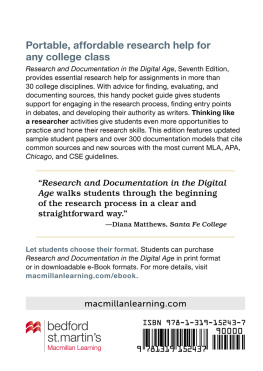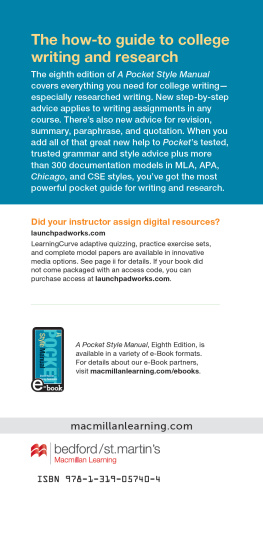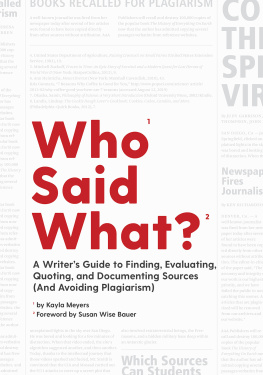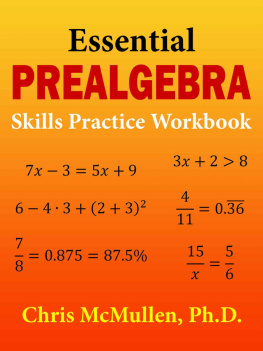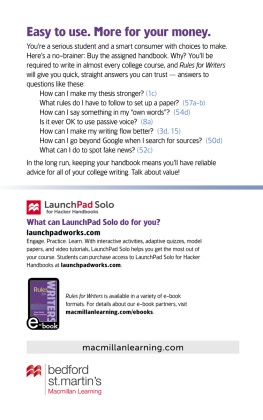Contents
Landmarks
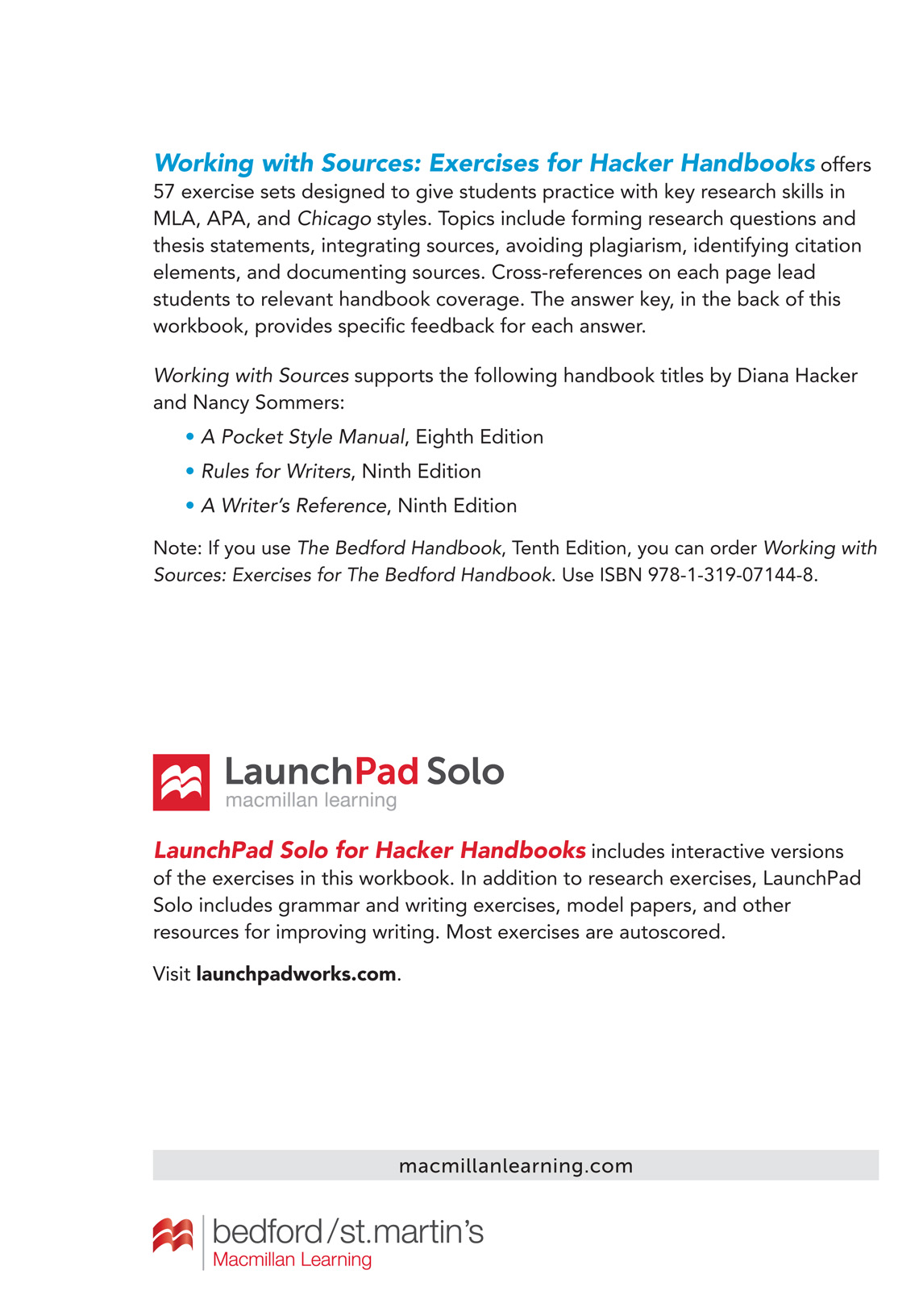
Working with Sources: Exercises for Hacker Handbooks offers 57 exercise sets designed to give students practice with key research skills in MLA, APA, and Chicago styles. Topics include forming research questions and thesis statements, integrating sources, avoiding plagiarism, identifying citation elements, and documenting sources. Cross-references on each page lead students to relevant handbook coverage. The answer key, in the back of this workbook, provides specific feedback for each answer.
Working with Sources supports the following handbook titles by Diana Hacker and Nancy Sommers:
A Pocket Style Manual, Eighth Edition
Rules for Writers, Ninth Edition
A Writers Reference, Ninth Edition
Note: If you use The Bedford Handbook, Tenth Edition, you can order Working with
Sources: Exercises for The Bedford Handbook. Use ISBN 978-1-319-07144-8.
LaunchPad Solo for Hacker Handbooks includes interactive versions of the exercises in this workbook. In addition to research exercises, LaunchPad Solo includes grammar and writing exercises, model papers, and other resources for improving writing. Most exercises are autoscored.
Visit launchpadworks.com.
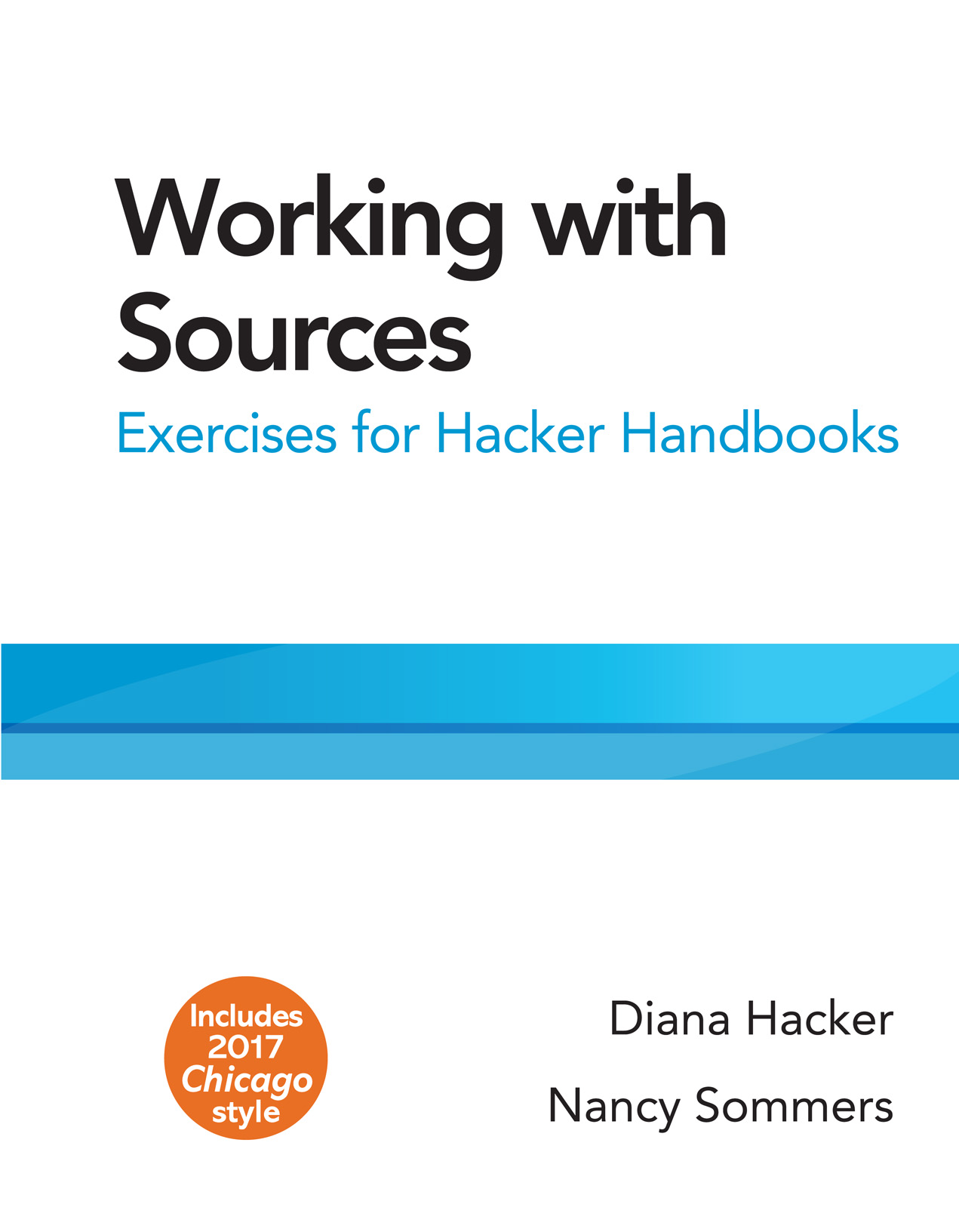
Working with Sources
Exercises for
Hacker Handbooks
Working with Sources
Exercises for
Hacker Handbooks
Diana Hacker
Nancy Sommers
Harvard University

Copyright 2018, 2017, 2014, 2010 by Bedford/St. Martins
All rights reserved.
Instructors who have adopted a Hacker handbook as a textbook for a course are authorized to duplicate portions of this manual for their students.
Manufactured in the United States of America.
210987
fedcba
For information, write: Bedford/St. Martins, 75 Arlington Street, Boston, MA 02116
ISBN 978-1-319-14578-1 (EPUB)
Acknowledgments
Text acknowledgments and copyrights appear at the back of the book on , which constitutes an extension of the copyright page. Art acknowledgments and copyrights appear on the same page as the art selections they cover.
A Note for Instructors
The exercises in this book offer practice in key research and documentation skills: forming research questions, determining effective thesis statements, integrating sources, avoiding plagiarism, recognizing common knowledge, documenting sources, and identifying citation elements in sources. If you have adopted a Hacker handbook for your course, you are welcome to photocopy any or all of these exercises for a variety of possible uses:
- homework
- classroom practice
- quizzes
- individualized self-teaching assignments
- support for a writing center or learning lab
This exercise workbook is also available for student purchase.
After a general exercise set on forming research questions, the exercises are organized by documentation style. If you ask your students to use MLA style, see . Most exercise sets begin with an example that is done for the student followed by five or ten items. Some items are multiple choice; others ask students to revise. The exercises are double-spaced so students can revise directly on the pages of the booklet.
This booklet includes a useful answer key (see ). Students will find correct answers accompanied by instructive feedback so that they will never have to guess why the correct answer is correct.
Using Working with Sources
Working with Sources is a tool that allows students to practice the research and documentation skills they will need for the writing they do in college courses. This resource supports students who are using any Hacker/Sommers handbook.
The exercises listed in the left-hand column correlate to the section numbers under the titles of the different handbooks. If you have questions as you work through an exercise, see the handbook section listed to the right of the exercise topic and under the title of the book you use in your course.
| Exercise Topic | A Writers Reference, 9th edition | Rules for Writers, 9th edition | A Pocket Style Manual, 8th edition |
|---|
| Research questions | R1-b | 50a | 25 |
| MLA |
| Thesis statements in MLA papers 1 | MLA-1a | 53a | 29 |
| Thesis statements in MLA papers 2 | MLA-1a | 53a | 29 |
| Avoiding plagiarism in MLA papers 1 | MLA-2 | 54 | 30 |
| Avoiding plagiarism in MLA papers 2 | MLA-2 | 54 | 30 |
| Avoiding plagiarism in MLA papers 3 | MLA-2 | 54 | 30 |
| Avoiding plagiarism in MLA papers 4 | MLA-2 | 54 | 30 |
| Avoiding plagiarism in MLA papers 5 | MLA-2 | 54 | 30 |
| Recognizing common knowledge in MLA papers | MLA-2 | 54b | 30 |
| Integrating sources in MLA papers 1 | MLA-3 | 55 | 31 |
| Integrating sources in MLA papers 2 | MLA-3 | 55 | 31 |
| Integrating sources in MLA papers 3 | MLA-3 | 55 | 31 |
| Integrating sources in MLA papers 4 | MLA-3 | 55 | 31 |
| MLA documentation: in-text citations 1 | MLA-4a | 56a | 33a |
| MLA documentation: in-text citations 2 | MLA-4a | 56a | 33a |
| MLA documentation: in-text citations 3 | MLA-4a | 56a | 33a |
| MLA documentation: identifying elements of sources | MLA-4b | 56b | 33 |
| MLA documentation: works cited 1 | MLA-4b | 56b | 33b |
| MLA documentation: works cited 2 | MLA-4b | 56b | 33b |
| MLA documentation: works cited 3 | MLA-4b | 56b | 33b |
| MLA documentation | MLA-4 & MLA-5 | 56 & 57 | 33 |
| APA |
| Thesis statements in APA papers 1 | APA-1a | 58a | 35 |
| Thesis statements in APA papers 2 | APA-1a | 58a | 35 |
| Avoiding plagiarism in APA papers 1 | APA-2 | 59 | 36 |
| Avoiding plagiarism in APA papers 2 | APA-2 | 59 | 36 |
| Avoiding plagiarism in APA papers 3 | APA-2 | 59 | 36 |
| Avoiding plagiarism in APA papers 4 | APA-2 | 59 | 36 |
| Recognizing common knowledge in APA papers | APA-2 | 59 | 36 |
| Integrating sources in APA papers 1 | APA-3 | 60 | 37 |
| Integrating sources in APA papers 2 | APA-3 | 60 | 37 |
| Integrating sources in APA papers 3 | APA-3 | 60 | 37 |
| Integrating sources in APA papers 4 | APA-3 | 60 | 37 |
| APA documentation: in-text citations 1 | APA-4a | 61a | 38a |
| APA documentation: in-text citations 2 | APA-4a | 61a | 38a |
|


